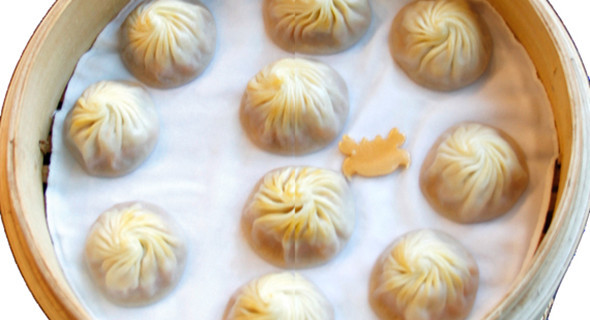

There is no feeling quite like picking up a fresh dumpling on the verge of bursting out of its semi-transluscent skin and nibbling a small hole in the skin to suck out the devilishly good filling: orgasmic. And while it's a big wide world of dumplings out there, the crabby goodness of 小笼包 (xiǎolóngbāo) is surely king in the dumpling stakes.
Literally "small steaming basket buns", xiǎolóngbāo is not your average dumpling. This type of bun bears the typical characteristics of Jiangnan (immediate south of the lower reaches of Yangtze River) cuisine, boasting intricate folds, a delicate size, the softest yet juicy texture, and an incredible explosion of salacious flavors. Whether it's pork, bamboo shoots, or shrimp, the filling is always minced to ensure softness and saturation, epitomizing the Jiangnan taste.
If xiǎolóngbāo could be crowned the king of bāozi, then crab roe xiǎolóngbāo is surely the king of kings. After cooking slowly on a low heat, the essence of the crab, its meat, and roe, exudes the rich smell of seafood and a golden shine with shades of orange. Only then can it be used with ground pork for the filling. Besides the smell and color of the filling, the sensation of eating a xiǎolóngbāo is heightened by its extremely creamy texture.
As the epitome of Chinese bāozi and mántou culture, xiǎolóngbāo didn't come into being until the Qing Dynasty (1616-1911). Given the varieties of xiǎolóngbāo in different cities in Zhejiang, Jiangsu, and Shanghai, there is much dispute as to how the thin-skinned juicy mutation came into being. In Wuxi and Changzhou, both famous for their crab roe xiaolongbao, the history of the dish is traced back to as early as the 1700s, when Emperor Qianlong (乾隆) was documented to have tasted this divine ethnic snack. A Changzhou saying demonstrates just how much esteem these tasty little buns carry: "It's better to let people wait for the buns, than let the buns wait for people" (宁可人等馒头,不可馒头等人).
The famous Nanxiang xiǎolóngbāo (南翔小笼包) on the other hand, was born when a bakery in the ancient town of Nanxiang (now a district in Shanghai) decided to reinvent traditional buns and give them a creative spin. The large size and the thick skin of mantou was modified, and the chef invented a method of adding frozen broth into the filling so that the brothy flavor would be locked into the wrapping when steamed.
Copyright ©1999-2018
Chinanews.com. All rights reserved.
Reproduction in whole or in part without permission is prohibited.